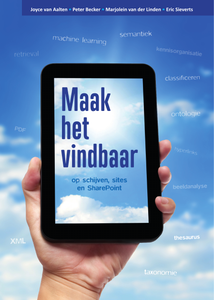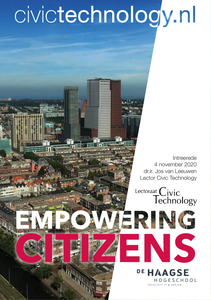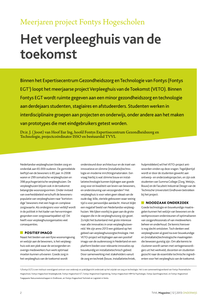Het beheer van grote hoeveelheden documenten vormt een steeds grotere uitdaging voor organisaties. Of het nu gaat om bestaande of nieuwe informatiesystemen, lokaal of in de cloud, informatiemanagers stellen zich de vraag welke mogelijkheden er zijn om de toegankelijkheid en vindbaarheid van de informatie zo effectief mogelijk te realiseren. Een goede vindbaarheid bespaart immers vele uren arbeidstijd en voorkomt incomplete dossiers. Traditionele instrumenten als taxonomieën, thesauri en autorisatielijsten bewijzen daarbij nog dagelijks hun waarde en de technische ontwikkelingen hebben de mogelijkheden uiteraard verruimd: automatische indexering en klassering, ontologieën en hyperlinking zijn waardevolle aanvullingen. In dit boek behandelen we belangrijke methoden en technieken om informatie (documenten) van een organisatie vindbaar te maken. De theorie van de toegankelijkheidsleer wordt vanaf de basis behandeld en aan de hand van vele voorbeelden komen technieken en instrumenten als taxonomie, thesaurus, ontologie, zoekmachine en classificatie aan de orde, inclusief stappenplannen om hier zelf mee aan de slag te gaan. Omdat SharePoint een veelgebruikt platform is voor het beheren en delen van documenten, besteden we een apart hoofdstuk aan de wijze waarop documenten binnen SharePoint zo goed mogelijk vindbaar kunnen worden gemaakt. De hoofdstukken worden afgewisseld met kaderteksten waarin specifiek wordt ingegaan op gerelateerde onderwerpen als XML, machine learning en cardsorting. Iedereen die in de praktijk betrokken is bij de implementatie van een informatiesysteem of in opleiding is tot informatieprofessional kan putten uit de uitgebreide beschrijvingen en handvatten die dit werk biedt. Omdat studenten een deel van de doelgroep vormen, is dit werk als open textbook onder een Creative Commons licentie gratis te downloaden. Originele document: https://udocstore.nl/docs/9789492388001 Joyce van Aalten (docent bij GO Opleidingen) Peter Becker (docent informatiebeheer aan de Haagse Hogeschool en GO Opleidingen) Marjolein van der Linden (docente aan de Hogeschool van Amsterdam, opleiding Media Informatie en Communicatie en bij de opleiding Communicatie) Eric Sieverts (docent bij VOGIN en GO Opleidingen)
DOCUMENT

In het eerste deel van een tweeluik over het project 'Cultuur in context' wordt de balans opgemaakt. In dit project werden databestanden van een aantal cultureel-erfgoed instellingen en wetenschappelijke instituten aan elkaar gekoppeld. Om die data te kunnen koppelen ontwikkelden de samenwerkende instellingen een ontologie.
DOCUMENT

Purpose People with dementia (PwD) often present Behavioral and Psychological Symptoms of Dementia, which include agitation, apathy, and wandering amongst others, also known as challenging behaviors (CBs). These CBs worsen the quality of life (QoL) of the PwD and are a major source/reason of (increased) caregiver burden. The intricate nature of the symptoms implies that there is no “one size fits all solution”, and necessitates tailored approaches for both PwDs and caregivers. To timely prevent these behaviors assistive technology can be utilized to guide caregivers by enabling remote monitoring of contextual, environmental, and behavioral parameters, and subsequently alarming nurses on early-stage behavioral changes prior to the presentation of CBs. Eventually, the system should propose an intervention/action to prevent escalation. In turn, improvement in QoL for both caregivers and PwD living in nursing homes (NHs) is expected. In the current project “MOnitoring Onbegrepen Gedrag bij Dementie met sensortechnologie” (MOOD-Sense), we aim to develop such a monitoring system. The strengths of this new monitoring system lie in its ability to align with the individual needs of the PwD, utilization of a combination of wearables and ambient sensors to obtain contextual data, such as location or sound, and predict or monitor CBs individually rather than in groups, thus facilitating person-centered care, based on ontological reasoning. The project is divided into three parts, Toolbox A, B and C. Toolbox A focuses on obtaining insight in which behaviors are challenging according to nurses and how they are described. Previous studies utilize clinical terminology to describe or classify behavior, we aim to employ concrete descriptions of behavior that are observable and independent of clinical terminology, aligning with nurses who are often the first to notice behavior and can be operationalized such that it can also be aligned with sensor data. As a result, an ontology will be developed based on the data such that sensor data can be integrated into the same conceptual information that standardizes the communication in our monitoring system. Toolbox B focuses on translating data coming from various sensors into the concepts expressed in the ontology, and timely communicate situations of interest to the caregivers. In Toolbox C the focus is exploring interventions/actions employed in practice to prevent CBs. Method In Toolbox A we used a qualitative approach to collect descriptions of CBs. For this purpose, we employed focus groups (FGs) with nursing staff who provide daily care to PwD. In Toolbox B pilot studies were conducted. A set of experiments using sensors in NHs were performed. During each pilot, multiple PwD with CBs in NHs were monitored with both ambient and wearables sensors. The pilots were iteratively approached, which means that insights from previous pilot studies were used to improve consecutive pilot studies. Lastly, the elaboration of Toolbox C is ongoing. Results and Discussion Regarding Toolbox A four FGs were conducted during the period from January 2023 to May 2024. Each FG was comprised of four nurses (n = 16). From the FGs we gained insights into behavioral descriptions and the context of CBs. Although data analysis has to be performed yet, there are indications that changes preceding CBs can be observed, such as frowning or clenching fists for agitation or aggression. Further results will be available soon. Regarding Toolbox B a monitoring system, based on sensors, is developed iteratively (see Figure 1) and piloted in three consecutive NHs from January 2021 to December 2023. Each pilot was comprised of two PwD (n = 6). Analysis of sensor data is ongoing.
LINK
Organisations operate in an increasingly dynamic environment. Consequently, the business models span several organisations, dealing with multiple stakeholders and their competing interests. As a result, the enterprise information systems supporting this new market setting are highly distributed, and their components are owned and managed by different stakeholders. For successful businesses to exist it is crucial that their enterprise architectures are derived from and aligned with viable business models. Business model ontologies (BMOs) are effective tools for designing and evaluating business models. However, the viability perspective has been largely neglected. In this paper, current BMOs have been assessed on their capabilities to support the design and evaluation of viable business models. As such, a list of criteria is derived from literature to evaluate BMOs from a viability perspective. These criteria are subsequently applied to six well-established BMOs, to identify a BMO best suited for design and evaluation of viable business models. The analysis reveals that, although none of the BMOs satisfy all the criteria, e3-value is the most appropriate BMO for designing and evaluating business models from a viability perspective. Furthermore, the identified deficits provide clear areas for enhancing the assessed BMOs from a viability perspective.
DOCUMENT

Bespreking van competenties waarover de 'Digitale Bibliothecaris' dient te beschikken op het gebied van management en organisatie, managen van informatiebronnen, managen van informatiediensten, toepassen van ict-hulpmiddelen. Het hoofdstuk eindigt met 10 eisen die je aan de 'ideale digitale bibliothecaris' zou mogen stellen. [Peter Becker en Jos van Helvoort]
DOCUMENT

Overgewaaid uit de VS begint in Nederland spoken word ook steeds meer vaste voet aan de grond te krijgen. Dichter en onderzoeker Anne Braakman legde zijn oor te luister in de spoken word-scene en beschrijft in dit artikel zijn bevindingen. Hij zag dat drie waarden centraal staan: expressie, community en (maatschappelijke) beïnvloeding. Dit artikel gaat over spoken word. In de spoken word-scene dragen mensen – die zichzelf afwisselend aanduiden als woordkunstenaar, spoken word-artiest, dichter, poëet, schrijver, performer, schrijvende performer of performende schrijver – gedichten voor aan een publiek. Soms is hier muzikale begeleiding bij, maar doorgaans niet. De gedichten zijn geschreven ‘om (vooral) gehoord te worden’ (Van der Starre, 2019, p. 1). Er is groeiende academische aandacht voor spoken word. Vooral in de Engelstalige literatuur, die vaak gaat over de situatie in de Verenigde Staten, bestaan bijvoorbeeld studies over slam poetry (Somers-Willett, 2005) en over spoken word in educatieve contexten als scholen, buurthuizen of volwassenenonderwijs (Merriweather, 2011; Williams, 2015; Fisher, 2003). Soms wordt het besproken als critical pedagogy in de context van rap en hiphop (Biggs-El, 2012) of als alternatieve en kritische kennisbron voor de dominante cultuur (Fisher, 2003; Chepp, 2012). Er lijkt echter relatief weinig aandacht te zijn voor spoken word als op zich staand fenomeen. Ook is er in de literatuur geen eenstemmige definitie of een afbakening van het genre, en is er evenmin onderzoek over (het relatieve belang van) de verschillende historische wortels. In Nederland bestaat zo goed als geen academische literatuur over spoken word. Aan het voordragen van poëzie wordt wel aandacht besteed (Dera, 2014; Franssen, 2012), maar spoken word is nog amper zichtbaar. Van der Starre (2021) besteedt in haar proefschrift over wat gedichten betekenen voor mensen in het voorbijgaan aandacht aan spoken word, vooral in relatie tot het literaire establishment. In een eerdere publicatie (Van der Starre, 2017) besteedt ze aandacht aan slam poetry en performance.Dit artikel beschrijft een (auto-)etnografisch geïnspireerde exploratieve casestudie naar de Nederlandse spoken word-scene en maakt daarmee een begin met het vullen van de kennislacune. Centrale onderzoeksvraag in dit artikel luidt: Wat is de waarde van participatie voor de beoefenaars van spoken word? Om die waarde te onderzoeken richt ik me uitgebreid op het tweede compartiment uit het in de inleiding van dit themanummer besproken model van Bisschop Boele. Daarnaast besteed ik en passant ook aandacht aan de andere drie compartimenten. Zo begin ik met korte beschrijvingen van twee spoken word-bijeenkomsten, gebaseerd op mijn veldwerkaantekeningen: een bewust gefragmenteerde versie van een thick description (compartiment 1uit het model). Ik vul deze eerste blik op de scene aan met een beknopte beschrijving van de geschiedenis en de maatschappelijke situering (compartiment 4) van het genre. Vervolgens beschrijf ik de gekozen theoretische achtergronden en de methodologie en de bevindingen van mijn onderzoek. De teksten in kaders zijn mijn eigen poëtische reflecties tijdens mijn onderzoek.
DOCUMENT

In ons dagelijkse leven hebben we veel met technologie te maken, vaak met interactieve, informatie-gerichte technologie: als consument doen we online boodschappen – zeker in deze pandemische tijd; als reiziger in het openbaar vervoer plannen en betalen we onze reis met interactieve technologie – nu weliswaar even wat minder; als weggebruiker navigeren we op basis van technologie; en ons energieverbruik in huis wordt ‘smart’ gemeten en geadministreerd. Als burger staan we steeds vaker middels technologie in contact met overheden. Denk aan alle online communicatie met de overheid, zo als de belastingdienst en gemeenten die middels apps, websites en de ‘Berichtenbox’ van ‘MijnOverheid’ met burgers communiceren. En er wordt over burgers en ons gedrag al heel wat data verzameld, door gemeenten, de politie, door bijvoorbeeld de zorgsector. En ook in de publieke ruimte wordt data verzameld – met smart city technologie, zoals camera’s en sensoren – met als doel om de stad veiliger, efficiënter en leefbaarder te maken. Al die ‘big data’ maakt het mogelijk om inzichten te genereren – al dan niet met kunstmatige intelligentie – en besluiten te nemen. We gebruiken technologie ook om als burger zelf actie te ondernemen. Bij de overheid kunnen we met apps melden wat er op straat verbeterd of onderhouden moet worden. Met onze buren zitten we in een WhatsApp groep of NextDoor, om bij te dragen aan de leefbaarheid en veiligheid van de buurt. We kunnen met smart home tools of citizen science kits de luchtkwaliteit meten, binnenshuis, maar ook buitenshuis. We tekenen petities, doen mee aan peilingen en enquêtes. En social networking sites (SNS) worden intensief gebruikt, voor sociale en professionele relaties, maar ook om maatschappelijk actief te zijn, voor het organiseren van het samenleven in een buurt. We weten inmiddels dat social media ook een effectief kanaal zijn om de democratie te beïnvloeden. Burgers komen dus in aanraking met veel verschillende technologieën, met verschillende doelstellingen, resultaten en bijeffecten, en waaraan mensen in allerlei functies en rollen deelnemen. Wat centraal staat in het vakgebied Civic Technology is dat de technologie in dienst staat van het burgerschap.
DOCUMENT

Binnen het Expertisecentrum Gezondheidszorg en Technologie van Fontys (Fontys EGT1) loopt het meerjaarse project Verpleeghuis van de Toekomst (VETO). Binnen Fontys EGT wordt ruimte gegeven aan een minor gezondheidszorg en technologie aan derdejaars studenten, stagiaires en afstudeerders. Studenten werken in interdisciplinaire groepen aan projecten en onderwijs, onder andere aan het maken van prototypes die met eindgebruikers getest worden.
DOCUMENT

Het aantal ouderen in ons land neemt toe en mensen willen en moeten langer thuis wonen. Zo zal de verpleeghuiscapaciteit afnemen en de zorg thuis en zelfzorg toenemen. Ook kunnen mantelzorgers en zorgprofessionals baat hebben bij extra ondersteuning. Technologie kan hiervoor een oplossing bieden.
DOCUMENT

De toenemende vergrijzing vergroot de druk op het zorgstelsel. Om zo lang mogelijk zelfstandig thuis te kunnen wonen, is gezonde voeding van belang. Ouderen worstelen echter met, soms conflicterende, waarden die zij toekennen aan eten, zoals gezondheid, smaak en gezelligheid. Tegelijkertijd lukt het professionals onvoldoende om voedingszorg aan te laten sluiten bij de waarden van ouderen rondom ‘goed eten’. Daarvoor was een goed gesprek over de waarden van eten tussen ouderen en zorgprofessionals nodig. LinkedIn: https://www.linkedin.com/in/matthijs-fleurke-66279110/ https://www.linkedin.com/in/dorien-voskuil-9b27b115/
DOCUMENT
